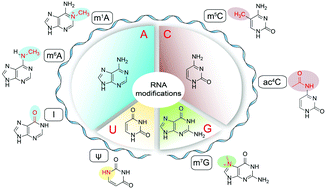Chemical methods and advanced sequencing technologies for deciphering mRNA modifications
Abstract
RNA modification, like other epigenetic modifications such as DNA modification and histone modification, is an emerging player in the field of the posttranscriptional regulation of gene expression. More than 160 kinds of RNA modifications have been identified, and they are widely distributed in different types of RNA. Recently, researchers have increasingly used advanced technologies to study modified nucleic acids in order to elucidate their biological functions and expand the understanding of the central laws of epigenetics. In this tutorial review, we comprehensively outline current advanced techniques for decoding RNA modifications, highlighting some of the bottlenecks in existing approaches as well as new opportunities that may lead to innovations. With this review, we expect to provide chemistry and biology students and researchers with ideas for solving some challenging problems, such as how to simultaneously detect multiple types of modifications within the same system. Moreover, some low-coverage modifications that may act as ‘candidates’ in important transcriptional processes need to be further explored. These novel approaches have the potential to lay a foundation for understanding the nuanced complexities of the biological functions of RNA modification.



 Please wait while we load your content...
Please wait while we load your content...